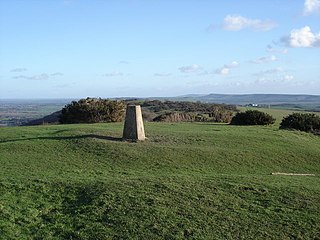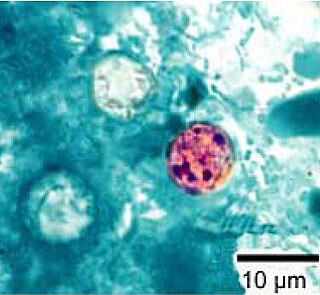
The Eurasian blackcap, usually known simply as the blackcap, is a common and widespread typical warbler. It has mainly olive-grey upperparts and pale grey underparts, and differences across the five subspecies are small. Both sexes have a neat coloured cap to the head, black in the male and reddish-brown in the female. The male's typical song is a rich musical warbling, often ending in a loud high-pitched crescendo, but a simpler song is given in some isolated areas, such as valleys in the Alps. The blackcap's closest relative is the garden warbler, which looks quite different but has a similar song.

The garden warbler is a common and widespread small bird that breeds in most of Europe and in the Palearctic to western Siberia. It is a plain, long-winged and long-tailed typical warbler with brown upperparts and dull white underparts; the sexes are similar and juveniles resemble the adults. Its two subspecies differ only slightly and interbreed where their ranges overlap. Due to its lack of distinguishing features, this species can be confused with a number of other unstreaked warblers. The garden warbler's rich melodic song is similar to that of the blackcap, its closest relative, which competes with it for territory when nesting in the same woodland.

The blackcap babbler is a member of the family Leiothrichidae.
Isospora is a genus of internal parasites in the subclass Coccidia.

The Eucoccidiorida are an order of microscopic, spore-forming, single-celled parasites belonging to the apicomplexan class Conoidasida. Protozoans of this order include parasites of humans, and both domesticated and wild animals including birds. Among these parasites are the Toxoplasma gondii that cause toxoplasmosis and Isospora belli, which results in isosporiasis.

Royal Naval Air Station Stretton, was an airfield situated in the village of Appleton Thorn, though named for the neighbouring village of Stretton, south of Warrington, in Cheshire, England. Although the main runway remains, the northerly part of the airfield is now HM Prison Thorn Cross, and an industrial estate. In the 1970s, the M56 motorway was built across the former air station.

The blackcap basslet, or blackcap gramma, is a species of fish inhabiting reefs in the tropical western Atlantic Ocean. It prefers vertical surfaces with crevices in which it can hide. It can be found at depths of from 10 to 180 metres. This species can also be found in the aquarium trade.

Blackcap is a hill and nature reserve in East Sussex, England. It is on a peak of the South Downs, just south east of Plumpton and west of Lewes. The flatter landscape is made up of open ground with chalk paths, surrounded by thickets. The steeper ground leading up to the ridge is low-density woodland. The top is more open, with patches of pine woodland and gorse bushes.

Eimeriidae is a family of Apicomplexa. It contains the following genera:
Isospora hammondi is an apicomplexan parasite of the genus Isospora that infects the marsh rice rat. It was discovered at Tuskegee National Forest, Macon County, Alabama, and formally described in 1971. The specific name honors Dr. Datus M. Hammond of Utah State University.

Cyclospora is a genus of apicomplexan parasites. It includes the species Cyclospora cayetanensis, the causative agent of cyclosporiasis. Members of Cyclospora are characterized as having oocysts with two sporocysts, each containing two sporozoites.

Cystoisospora is a genus of parasitic alveolates belonging to the phylum Apicomplexa.
Atoxoplasma is a genus of parasitic alveolates in the phylum Apicomplexa. The species in this genus infect birds. They are spread by the orofaecal route.

Black Cap Mountain is a 1,020 foot (310 m) mountain in Penobscot County, Maine, United States. The mountain is 5 miles (8.0 km) southeast of Eddington, Maine, and the Penobscot River. It is accessible from Maine Route 46, near its intersection with The Airline.
Hyaloklossia is a genus of parasitic alveolates in the phylum Apicomplexa. Only two species in this genus are currently recognised.
The 2011–12 Ford Trophy was the 41st season of the official List A domestic cricket competition in New Zealand. This season was the first in a sponsorship deal between New Zealand Cricket and Ford Motor Company. The competition ran from 25 November 2011 to 12 February 2012, and was won by the Central Districts Stags.
Isospora sylvianthina is a species of internal parasites classified under Coccidia. It frequently occurs in the Eurasian blackcap and the garden warbler.
Isospora sylviae is a species of internal parasite classified under Coccidia. It frequently occurs in the Eurasian blackcap and the garden warbler.

Cystoisospora belli, previously known as Isospora belli, is a parasite that causes an intestinal disease known as cystoisosporiasis. This protozoan parasite is opportunistic in immune suppressed human hosts. It primarily exists in the epithelial cells of the small intestine, and develops in the cell cytoplasm. The distribution of this coccidian parasite is cosmopolitan, but is mainly found in tropical and subtropical areas of the world such as the Caribbean, Central and S. America, India, Africa, and S.E. Asia. In the U.S., it is usually associated with HIV infection and institutional living.
Cystoisospora canis, previously known as Isospora canis, is a microscopic, coccidian parasite that causes an intestinal tract infection in dogs. The intestinal tract infection is coccidiosis caused by a protozoa called coccidia.










